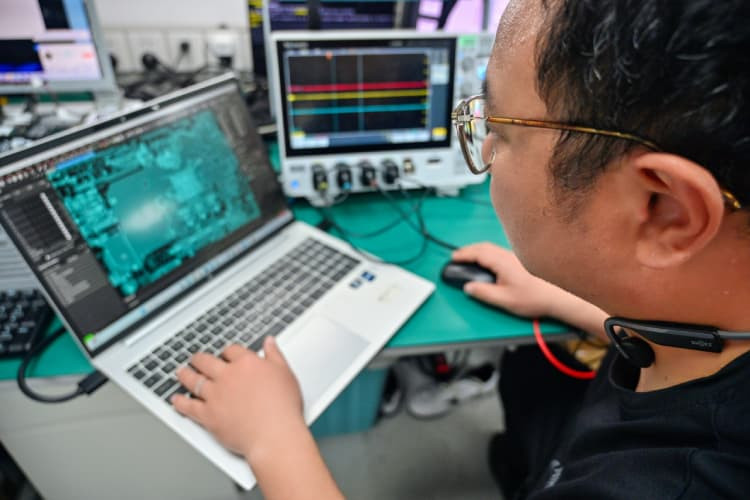Intel and Lenovo Redefine Premium Laptops with AI
In The News | 30-06-2025 | By Matthew Walker

Key Takeaways:
- Lenovo Aura Edition laptops, co-engineered with Intel, launched in September 2024 with 11 devices spanning consumer, commercial, and SMB markets.
- Built on insights from over 10,000 users and tested by 4,000+ beta users, the platform prioritises battery life, thermal performance, and smart AI features like Smart Share.
- Engineering breakthroughs include LPDDR5x memory up to 8,533 MT/s, optimised thermal design, and all-day battery life in ultra-slim devices.
- Future laptops will be powered by Intel’s Panther Lake CPUs, with enhanced AI capabilities and next-gen efficiency on the roadmap.
Intel and Lenovo have taken a decisive step towards reshaping the premium laptop category with the launch of the Lenovo Aura Edition range. Developed over a two-year engineering partnership, the lineup introduces a new benchmark in AI-enhanced mobile computing, anchored in a co-design approach that prioritises both performance and usability.
Announced in September 2024, the Aura Edition portfolio includes 11 devices spanning consumer, commercial, and SMB segments. Each system reflects the outcomes of a collaborative design process that pushed beyond conventional hardware upgrades to focus on integrated intelligence and cross-device interaction.
Artificial intelligence sits at the core of the platform, enabling adaptive system behaviour, enhanced efficiency, and context-aware features tailored to modern workloads. This initiative also signals a notable shift in how premium systems are engineered, with user experience, longevity, and platform-level innovation taking precedence over incremental iteration.
The project stands as one of the most intensive co-engineering efforts between the two companies to date, setting the stage for a new phase in AI PC development that is both technically ambitious and commercially strategic.
User-Centric Design Backed by Scale
The Lenovo Aura Edition platform wasn’t just built for users; it was built with them. Drawing from an extensive pool of over 10,000 interviews, user reviews, and community feedback, Lenovo and Intel prioritised practical performance gains over theoretical benchmarks.
Key areas of concern, battery longevity, thermal stability, and intelligent task handling, formed the foundation for iterative hardware and software design. More than 4,000 beta testers were engaged throughout the prototyping phase, providing usage data across varied real-world scenarios.
This level of engagement helped validate and refine system behaviours. One outcome was Smart Share, a user-informed feature allowing frictionless photo transfer from phone to PC via tap, addressing long-standing pain points in device interoperability.
Beyond headline features, user insights also drove enhancements in display vibrancy, audio clarity, and thermal management. The result is a portfolio of laptops that deliver not just specifications, but a more responsive and integrated day-to-day experience.
Co-Engineering at Scale: Pushing the Platform Further
Delivering a truly next-generation PC platform required Lenovo and Intel to move beyond traditional vendor-partner dynamics. The Aura Edition project brought both teams into a shared engineering process, jointly addressing performance ceilings and structural limitations across hardware and firmware layers.
One standout advancement was the successful implementation of high-speed LPDDR5x memory running at up to 8,533 MT/s. Typically, pushing memory to these frequencies introduces stability risks, but through low-level circuit optimisation and firmware tuning, the joint engineering teams achieved stable performance without compromising system integrity.
This work was underpinned by architectural changes, particularly in thermal design and board layout, which enabled slimmer enclosures without sacrificing thermal headroom. Devices like the ThinkPad X1 Carbon Gen 13 Aura Edition and Yoga Slim 7i Aura Edition are direct beneficiaries of this work, delivering all-day battery life within ultraportable form factors.
Recognition is due to Bhavesh Shroff and Zheng Jiong, who led key phases of the platform co-development, helping resolve bottlenecks in memory throughput, power delivery, and system stability.
Independent validation of these gains has surfaced in third-party testing. Wccftech highlighted the Yoga Slim 7i Aura Edition’s battery performance, citing runtime of over eight hours in medium workloads and 11.5 hours under light loads, as confirmed by benchmark reviews from tech reviewer Dave2D.
Global Engineering, Local Execution
The Aura Edition programme was not the product of a single lab or region; it was the outcome of a globally distributed engineering effort. Intel and Lenovo teams collaborated across China, India, Malaysia, Israel, Taiwan, and the United States, tackling more than 50 engineering challenges across 10+ coordinated workstreams.
This extensive network enabled rapid iteration and deep technical problem-solving. A notable example emerged from Intel’s engineering group in Israel, which worked closely with Lenovo to develop and optimise an AI-driven image enhancement model, a key feature designed to elevate camera performance across the Aura Edition range.
In parallel, software optimisation was another pillar of the collaboration. Independent software vendors (ISVs), including Adobe, partnered directly with the platform teams to fine-tune performance across creative and productivity applications. Software like Adobe After Effects, Lightroom, and Premiere Pro were enhanced to take full advantage of the AI PC architecture, ensuring that creators benefit from both performance uplift and power efficiency.
This distributed approach to development, local execution within a global framework, enabled a faster, more responsive product cycle and ensured that Aura Edition systems launched with mature, field-tested functionality from day one.
The Road Ahead: Aura Edition and Beyond
While the Lenovo Aura Edition marks a major milestone in AI PC development, it also serves as the foundation for a broader roadmap. Intel and Lenovo have confirmed that future platforms will be built around Intel’s next-generation Panther Lake CPUs, based on the Intel 18A process node.
These upcoming systems are expected to deliver even greater gains in AI processing efficiency, battery performance, and platform integration, further pushing the boundaries of what intelligent computing looks like in mobile form factors.
As Sam Gao, vice president and general manager of Intel’s Client Computing Group in China, noted: “To lead in AI PC, we must run faster than all of our competitors. Delivering extraordinary results is not an option for the Aura Edition project; it’s a mandate.”
This signals that the current generation is just the beginning. With a multi-year collaboration already in motion, Intel and Lenovo are positioned to iterate rapidly and expand AI capabilities across the premium laptop market. For professionals, creators, and everyday users alike, the evolution of AI computing is accelerating, and the Aura Edition represents its first significant leap forward.
Closing Thoughts: A Blueprint for AI-Driven Innovation
The Lenovo Aura Edition isn’t just another product release; it represents a blueprint for collaborative engineering at scale. From silicon to software, the platform illustrates how deep technical partnerships can yield practical, user-driven innovation in a fast-evolving computing landscape.
In combining Intel’s architectural expertise with Lenovo’s hardware and systems integration, the project sets a new performance and design standard for AI-powered PCs. It also reflects a broader shift in the industry, where user feedback, cross-disciplinary engineering, and co-developed software solutions are becoming essential to delivering differentiated hardware.
As AI continues to reshape how we interact with technology, the Aura Edition stands as a case study in what’s possible when two leading technology firms align around a shared vision and execution strategy. It’s a forward-looking move, one that not only anticipates customer expectations, but builds the infrastructure to meet them.

